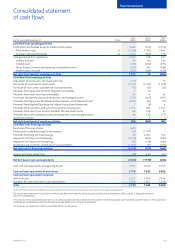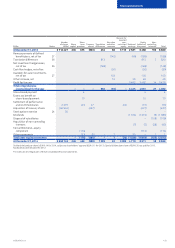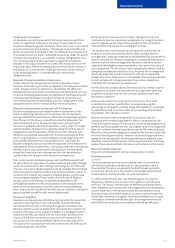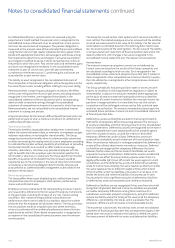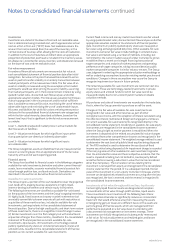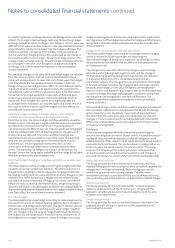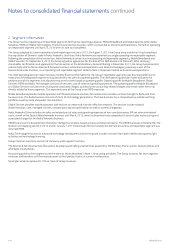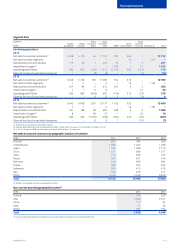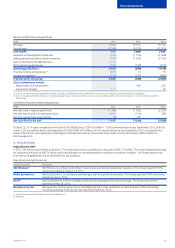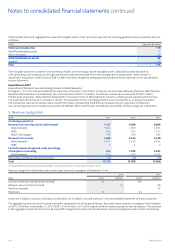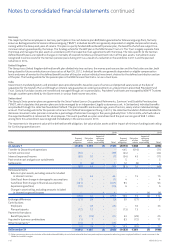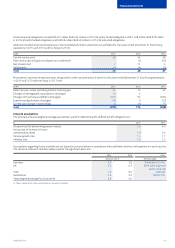Nokia 2014 Annual Report Download - page 139
Download and view the complete annual report
Please find page 139 of the 2014 Nokia annual report below. You can navigate through the pages in the report by either clicking on the pages listed below, or by using the keyword search tool below to find specific information within the annual report.
137
Financial statements
NOKIA IN 2014
Litigation and intellectual property rights (“IPR”) infringements
provisions
The Group provides for the estimated future settlements related to
litigation and asserted and unasserted past alleged IPR infringements
based on the probable outcome of potential claims.
Material liability provisions
The Group recognizes the estimated liability for non-cancellable
purchase commitments for inventory in excess of forecasted
requirements at each statement of nancial position date.
Other provisions
The Group provides for other contractual obligations based on the
expected cost of executing any such contractual commitments.
Treasury shares
The Group recognizes its own equity instruments that are acquired
(“treasury shares”) as a reduction of equity at cost of acquisition.
When cancelled, the acquisition cost of treasury shares is recognized
in retained earnings.
Dividends
Dividends proposed by the Board of Directors are recognized in the
consolidated nancial statements when they have been approved by
the shareholders at the Annual General Meeting.
Use of estimates and critical accounting judgments
The preparation of consolidated nancial statements in accordance
with IFRS requires the application of management judgment in
selecting appropriate assumptions for calculating nancial estimates.
Management bases its estimates on historical experience, expected
outcomes and various other assumptions that are believed to be
reasonable under the circumstances. These estimates form the basis
for the reported carrying values of assets and liabilities and recognized
revenues and expenses that may not be readily apparent from other
sources. Material estimates are revised if changes in circumstances
occur or as a result of new information or more experience. As
estimates inherently contain a varying degree of uncertainty, actual
outcomes may dier, resulting in additional charges or credits to the
consolidated income statement.
Management considers that the estimates, assumptions and
judgments about the following accounting policies represent the most
signicant areas of estimation uncertainty and critical judgment that
may have an impact on the Group’s nancial information.
Business combinations
The Group applies the acquisition method of accounting to account
for acquisitions of separate entities or businesses. The determination
of the fair value and allocation thereof to each separately identiable
asset acquired and liability assumed requires estimation and
judgment. Estimation and judgment are required in determining the
fair value of the acquisition, including the discount rate, the terminal
growth rate, the number of years on which to base the cash ow
projections, and the assumptions and estimates used to determine
the cash inows and outows. The discount rate reects current
assessments of the time value of money, relevant market risk
premiums, and industry comparisons. Risk premiums reect risks and
uncertainties for which the future cash ow estimates have not been
adjusted. Terminal values are based on the expected life of products
and forecasted life cycle, and forecasted cash ows over that period.
The assumptions are based on information available at the date of
acquisition; actual results may dier materially from the forecast as
more information becomes available. Refer to Note 4, Acquisitions.
Revenue recognition
The Group enters into transactions involving multiple components
consisting of any combination of hardware, services and software
where the Group identies the separate components and estimates
their relative fair values, considering the economic substance of the
entire arrangement. The fair value of each component is determined
by taking into consideration factors such as the price of the
component when sold separately and the component cost plus
a reasonable margin when price references are not available.
The determination of the fair value and allocation thereof to each
separately identiable component requires the use of estimates
and judgment which may have a signicant impact on the timing and
amount of revenue recognized. Refer to Note 5, Revenue recognition.
Pension benet obligations and expenses
The determination of pension benet obligations and expenses for
dened benet pension plans is dependent on a number of estimates
and assumptions, including the discount rate, future mortality rate,
and annual rate of increase in future compensation levels. A portion of
plan assets is invested in debt and equity securities, which are subject
to market volatility. Changes in assumptions and actuarial estimates
may materially aect the pension benet obligation and future
expense. Based on these estimates and assumptions, pension benet
obligations amount to EUR 1 884 million (EUR 1 453 million in 2013
for Continuing operations) and the fair value of plan assets amounts
to EUR 1 387 million (EUR 1 261 million in 2013 for Continuing
operations). Refer to Note 8, Pensions.
Income taxes
The Group is subject to income taxes both in Finland and a number
of other jurisdictions. Judgment is required in determining current
tax expense, uncertain tax positions, deferred tax assets and deferred
tax liabilities; and the extent to which deferred tax assets can be
recognized. Estimates are based on forecasted future taxable
income and tax planning strategies. Based on these estimates and
assumptions, tax losses carry forward, temporary dierences and
tax credits for which no deferred tax assets are recognized due to
uncertainty are EUR 2 386 million (EUR 10 693 million in 2013).
The utilization of deferred tax assets is dependent on future taxable
prot in excess of the prot arising from the reversal of existing
taxable temporary dierences. The recognition of deferred tax assets
is based on the assessment of whether it is more likely than not that
sucient taxable prot will be available in the future to utilize the
reversal of temporary dierences and tax losses. Recognition of
deferred tax assets involves judgment regarding the future nancial
performance of the particular legal entity or tax group that has
recognized the deferred tax asset.
Liabilities for uncertain tax positions are recorded based on estimates
and assumptions on the amount and likelihood of outow of economic
resources and the timing of payment when it is more likely than not
that certain positions will be challenged and may not be fully sustained
upon review by local tax authorities. Currently, the Group has ongoing
tax investigations in multiple jurisdictions, including India. Due to
the inherently uncertain nature of tax investigations, the ultimate
outcome or actual cost of settlement may vary materially from
estimates. Refer to Note 13, Income tax, and Note 14, Deferred taxes.


